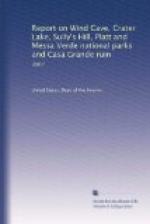[Illustration: Pl. LVI: Interior Wall of Casa Grande Ruin.]
The floors of the rooms, which were also the roofs of the rooms below, were of the ordinary pueblo type, employed also today by the American and Mexican population of this region. In the Casa Grande ruin a series of light joists or heavy poles was laid across the shorter axis of the room at the time the walls were erected; these poles were 3 to 6 inches in diameter, not selected or laid with unusual care, as the holes in the side walls which mark the places they occupied are seldom in a straight line, and their shape often indicates that the poles were quite crooked. Better executed examples of the same construction are often found in northern ruins. Over the primary series of joists was placed a layer of light poles, 11/2 to 2 inches in diameter, and over these reeds and coarse grass were spread. The prints of the light poles can still be seen on the walls. The floor or roof was then finished with a heavy coating of clay, trodden down solid and smoothed to a level. A number of blocks of this final floor finish, bearing the impress of the grass and reeds, were found in the middle room. There is usually a setback in the wall at the floor level, but this practice was not followed in all the rooms.
The position of the floor is well marked in all cases by holes in the wall, into which beams projected sometimes to a depth of 3 feet, and by a peculiar roughness of the wall. Plate LVI shows two floor levels, both set back slightly and the upper one strongly marked by the roughness mentioned. This roughness apparently marks the thickness of the floor in some cases, yet in others it is much too thick for a floor and must have had some other purpose. The relation of these marks to the beam holes suggests that in some cases there was a low and probably narrow bench around two or more sides of the room; such benches are often found in the present Pueblo villages.




